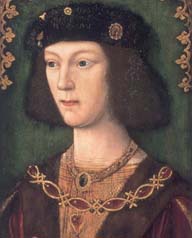 Although
I fully appreciate the beautiful gowns of historical women, I
am particularly drawn to dolls (or "action figures") of
famous men from history. Probably the most distinctive male monarch
that
has captured the attention of doll portraitists is Henry VIII
of England. Most portrait dolls I have found depict him in his later
years when he had become quite portly. Actually, Henry VIII was
a lithe, vibrant young man, as depicted in this portrait from
1509,
who loved to compete in tournaments.
Although
I fully appreciate the beautiful gowns of historical women, I
am particularly drawn to dolls (or "action figures") of
famous men from history. Probably the most distinctive male monarch
that
has captured the attention of doll portraitists is Henry VIII
of England. Most portrait dolls I have found depict him in his later
years when he had become quite portly. Actually, Henry VIII was
a lithe, vibrant young man, as depicted in this portrait from
1509,
who loved to compete in tournaments.
"From the start, the king's preference for the "pleasures of the age" sparked comment. Dancing, tilting, fencing, riding and fighting were all in a day's work for this action man. Combined with his intensive patronage of the arts and learning, Henry was hailed as a wonder of the age.
The musical never knew what it missed. The king would frequently sing for his courtiers, accompanying himself on virginal or lute. One of his tunes, "Pastime with Good Company," became a popular hit. A highly agile dancer, the king could also "leap like a stag." - Portrait of a King, PBS.org.
Unfortunately, his passion for jousting resulted in numerous injuries
to his legs. These injuries eventually caused ulcerations that made
it difficult for him to walk in later years.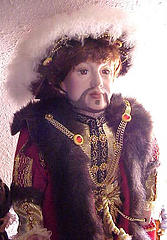
By 1520, Henry had grown the trademark beard. The doll by Regeancy
Arts is the only doll in my collection with the face of a younger
more active Henry. Regeancy's dolls of Henry's six wives, however,
are merely costume dolls and do not bear any resemblance 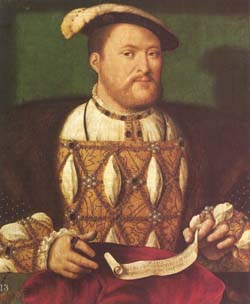 to the
actual women in Henry's life. They are beautiful however and
the costumes are lavishly adorned. I was able to purchase Henry
for
less than $30 although I've seen this doll sell for almost $50.
I purchased all six wives for only $22 each.
to the
actual women in Henry's life. They are beautiful however and
the costumes are lavishly adorned. I was able to purchase Henry
for
less than $30 although I've seen this doll sell for almost $50.
I purchased all six wives for only $22 each.
My
favorite portrait is the one at left of Henry at 43 done in 1535
by Joos Van Cleve. Henry has matured into quite a handsome man and,
although still instantly recognizable, he either has not yet acquired
the ponchy jowels of middle age or Van Cleve was being kind to him.
This would have been his appearance at the time he was married to
Anne Boleyn. Judging from Hans Holbein's famous portrait of Henry
in 1536, Henry must have started eating a lot, agonizing over what
to do with Queen Boleyn, who had produced only 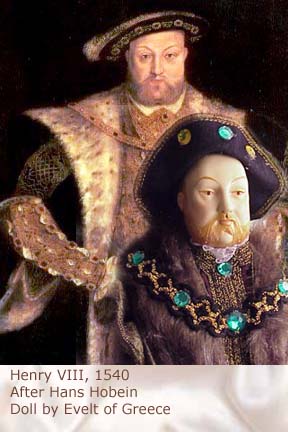 a daughter, Elizabeth.
a daughter, Elizabeth.
Ann had also become rather a harpie after enduring years of wrangling with the Roman Catholic Church over Henry's request for a divorce from his first wife Katherine of Aragon and Henry grew tired of her. Unfortunately for Anne, Henry chose the ax as the most convenient disposal method and she was executed after imprisonment in the Tower of London.
By 1540, he had gained even more weight, giving him the face by which he is most remembered. The doll at the right created by Greek doll manufacturer, Evelt, is probably the doll I have with the closest likeness to Henry's portraits of the period. Evelt's historical porcelain dolls command a new price of about 86 British pounds but if you are patient you can usually find them periodically up on Ebay for less than $40.
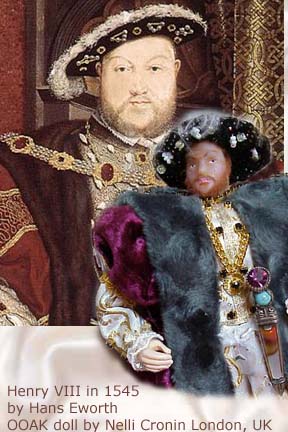 Ebay has opened up a whole world to doll collectors. I was the
successful bidder for a wonderfully detailed one-of-a-kind (OOAK)
Elizabeth I doll created by Nelli Cronin and she mentioned she
also had made a Henry VIII and all of his wives that I readily agreed
to buy as well. Nelli is originally from St. Petersburg, Russia
and is now married to an Englishman and lives in London. Her
finely
detailed Henry VIII is about 8" tall and is adorned with a
real human hair beard. Nelli visits Madame Toussaud's Wax Museum
and uses the wax figures there as models for some of her dolls.
Ebay has opened up a whole world to doll collectors. I was the
successful bidder for a wonderfully detailed one-of-a-kind (OOAK)
Elizabeth I doll created by Nelli Cronin and she mentioned she
also had made a Henry VIII and all of his wives that I readily agreed
to buy as well. Nelli is originally from St. Petersburg, Russia
and is now married to an Englishman and lives in London. Her
finely
detailed Henry VIII is about 8" tall and is adorned with a
real human hair beard. Nelli visits Madame Toussaud's Wax Museum
and uses the wax figures there as models for some of her dolls.
Perhaps, one of my favorite dolls of Henry in my collection was produced by Janet Oliver of Anchorage, Alaska. She knitted Henry from from patterns described in "Knitted Historical Figures" by Jan Messent. He event sports an elaborate "codpiece".
"The codpiece began as a flat piece of material covering an improvement in men's fashion -- a well placed slit. The codpiece remained flat cloth for a number of years. While visiting England, Duke Fabrizio of Bologna, dressing hastily after a quick romantic interlude, used the flap to contain (or perhaps restrain) his nether parts while appearing before King Henry VIII and Queen Anne Boleyn.
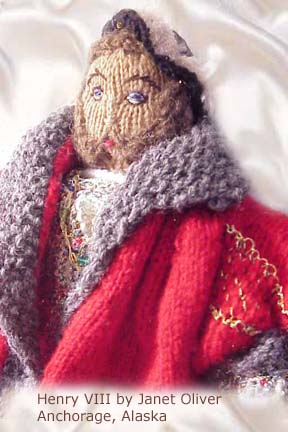 Queen Anne, amused at the Italian's conspicuous bulge, remarked "Be
that thine codling or art thou glad to see me?" Of course, "codling" is
15th century English for either a "small, immature apple" or "any
of several elongated greenish English cooking apples," so
we may never know if the Duke's fruit was being ridiculed or complimented.
Queen Anne, amused at the Italian's conspicuous bulge, remarked "Be
that thine codling or art thou glad to see me?" Of course, "codling" is
15th century English for either a "small, immature apple" or "any
of several elongated greenish English cooking apples," so
we may never know if the Duke's fruit was being ridiculed or complimented.
King Henry was very distressed by the whole business and assumed this bulge (from Middle French "boulge" meaning "leather bag" or "curved part", or perhaps "curved part in a leather bag") to be the latest Continental style in courtly fashions. He immediately ordered his codpieces padded in order that he not look out of date by comparison to Duke Fabrizio." - A Brief History of the Codpiece.
More Acquisitions of Henry VIII dolls and figures:
Dolls
of the Tudor Court
from Mary's
Historical Doll Collection
and other exhibits I have seen